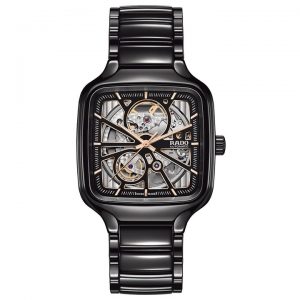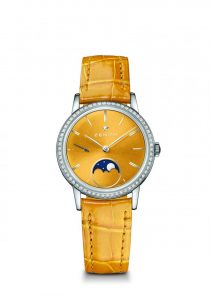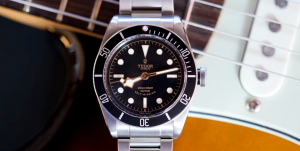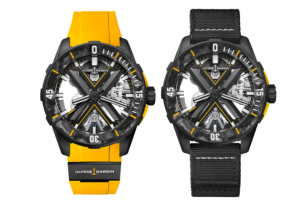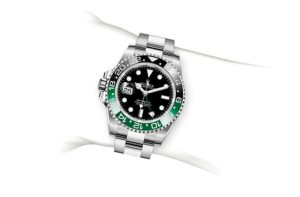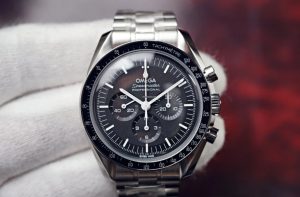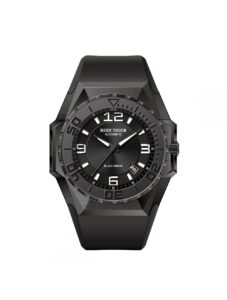

Two automatic watches with high-frequency movements, the Seiko Grand Seiko Hi-Beat 36000 and Zenith Espada, square off in a battle of the fast-beat balances in a piece by Martina Richter. With photos by Zuckerfabrik Fotodesign.
A fast-beat movement offers an advantage over its lower-frequency rivals: more beats per hour means greater precision. The principle is simple: the accuracy with which time can be measured and displayed is inversely proportional to the size of the units into which it is divided. Fast-beat movements are also more shock-resistant than slower-beat ones, and this is an added boon to precision. Two companies make series-produced movements with frequencies of 36,000 vph. One is Zenith; the other is Seiko. We tested one watch from each brand to find out how they measure up against each other in terms of precision and a host of other criteria.
The Zenith watch, called the Espada, is equipped with a modified version of the company’s celebrated El Primero movement. In its “natural” form, the El Primero is, of course, a chronograph movement. To make the Espada’s movement, a three-hand automatic caliber called the El Primero 4650B, Zenith removed the chronograph mechanism from the El Primero. The Seiko watch, called the Grand Seiko Hi-Beat 36000, contains the automatic Caliber 9S85, introduced in 2009. Both movements required much work to develop. Modifying the El Primero chronograph caliber to power a three-handed watch involved more than merely reducing the number of parts from 280 to 210. The stopwatch mechanism was removed, but it was partly reinstalled afterward. The bridges had to be redesigned and the continually running seconds hand relocated from an off-center subdial to the center of the dial. The resulting construction resembles the classic pattern of a basic caliber in which the central seconds hand is positioned directly within the flow of force rather than drawing its power from a rudiment left over from the chronograph mechanism.
Seiko faced its own challenges. It spent five years developing a special alloy, Spron 610, for its caliber’s hairspring (Seiko makes its own hairsprings and mainsprings). Spron 610 has greater resistance to shocks and magnetism than standard alloys. Because a high frequency puts additional stress on the movement, Seiko redesigned the lever, escape wheel and pallets to increase their longevity. It developed another alloy, Spron 530, for use in the caliber’s mainspring. Spron 530 enables the spring to withstand the stronger torque required by the high-frequency balance: the torque in five-hertz Caliber 9S85 is twice as high as in Seiko’s four-hertz calibers. The spring provides an impressive power reserve of 55 hours.
Five screws hold a window of sapphire in the back of the Espada, enabling us to see the new and compact bridge for the automatic-winding mechanism. The mechanism partially obstructed our view of the escapement and the polarizing train for the rotor, which winds the mainspring in both directions of rotation. Although our view was also blocked by the circularly grained bridge, there’s a large bridge beneath it: this construction comes from the former El Primero and covers the entire movement like a three-quarters plate. Stripping El Primero down to serve as a movement for a three-handed watch robs it of its chronograph architecture, but the movement still speaks Zenith’s language, thanks to the brand’s star-shaped logo cut in openwork into the rotor, the fine adjustment via an eccentric screw on an elongated regulator arm and, of course, the fast-paced balance. Seiko’s caliber 9S85 also makes a brand-specific statement behind a screwed-down window of sapphire in its caseback. Seiko fans will recognize the company’s trademark wavy embellishments, similar to Geneva waves, which decorate the bridges, the cocks and the slightly skeletonized rotor. Like the rotor on the Zenith movement, Seiko’s rotor winds the mainspring in both directions of rotation. Seiko uses its well-known Magic Lever pawl indexing system, which it introduced in 1959. The Magic Lever system increases the transfer of power to the mainspring and delivers faster winding speed by harnessing all the energy created by the rotor as it revolves in both directions.
The Espada’s sleek hands have a sporty look. The minutes hand is exactly long enough to touch the corresponding scale on the flange; its tip bends downward to minimize potential errors due to parallax. The hour hand has no downward curve at its end and its tip remains close to the 11 appliqués. The narrow seconds hand of blued steel adds a colorful accent. Its shorter end bears Zenith’s star logo. The dial on the Seiko watch is more understated than the Zenith dial. Narrow hour indices rise above a background that’s unobtrusively embellished with a sunburst pattern. Each index slopes downward toward the center of the dial. Neither the indices nor the hands are luminous so the watch can’t be read in the dark. The dial does not provide as much contrast as the Zenith dial does, so it isn’t quite as easy to make out even in daylight. Many shiny surfaces on the applied indices, plus glossy facets along the edges of the hands, tend to reflect sunlight and cause unwanted glare. Like Zenith’s watch, the Grand Seiko has a colorful accent: its narrow blued seconds hand. The dauphine hour and minutes hands end at the inner tips of the indices and the minute strokes, respectively. The latter are neatly marked. All in all, this dial is handsome and consistent, just like the Zenith dial.
